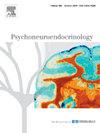妊娠期的荷尔蒙轨迹:皮质醇和催产素水平曲线。
IF 3.4
2区 医学
Q2 ENDOCRINOLOGY & METABOLISM
引用次数: 0
摘要
妊娠伴随着激素波动,包括皮质醇和催产素(OT)的增加。虽然这些激素在孕期的影响已被广泛研究,但它们的正常变异性还没有得到很好的确定。因此,我们评估了血清皮质醇和催产素水平在整个孕期的表现。这项纵向研究是巴西南部城市孕妇人群队列研究的一部分。我们对孕周在 24 周以内的孕妇进行了鉴定(第一波,983 人)和首次访谈后 60 天的评估(第二波,840 人)。在这两个时间段,我们都采集了血液样本,以检测荷尔蒙剂量。我们利用生长曲线模型研究了这些激素在整个孕期的变化轨迹。最拟合的模型是指数增长模型,其中方差解释了约 79.1 % 的结果。因此,皮质醇水平平均为 44.2 μg/dl(95 %CI:29.2;59.1,p<0.05)。本文章由计算机程序翻译,如有差异,请以英文原文为准。
The hormonal trajectory along gestational age: Cortisol and oxytocin levels profiles
Pregnancy is accompanied by hormonal fluctuation, including increased cortisol and oxytocin (OT). Although the implications of these hormones during pregnancy are extensively studied, their normative variability is not well established. Therefore, we evaluated how serum cortisol and OT levels behave throughout pregnancy. This longitudinal study is part of a population-based cohort of pregnant women living in a city in Southern Brazil. Pregnant women up to 24 gestational weeks were evaluated at the time of identification (1st wave, N=983) and 60 days after the initial interview (2nd wave, N=840). At both times, blood samples were collected for hormonal dosage. We investigated the trajectory of these hormones throughout pregnancy using growth curve modeling. The best-fitting model was the exponential growth model, in which the variance explains approximately 79.1 % of the outcome. Thus, the cortisol level was, on average, at 44.2 μg/dl (95 %CI: 29.2;59.1, p<0.001) in the first gestational week, with an increase of approximately 2.0 % (95 %CI: 1.01;1.02, p<0.001) each week. OT showed no significant changes. While cortisol appears to follow a trajectory of exponential increase, possibly in response to the demands of fetal development, the variation in OT levels throughout pregnancy still remains constant subject to further investigation.
求助全文
通过发布文献求助,成功后即可免费获取论文全文。
去求助
来源期刊

Psychoneuroendocrinology
医学-精神病学
CiteScore
7.40
自引率
8.10%
发文量
268
审稿时长
66 days
期刊介绍:
Psychoneuroendocrinology publishes papers dealing with the interrelated disciplines of psychology, neurobiology, endocrinology, immunology, neurology, and psychiatry, with an emphasis on multidisciplinary studies aiming at integrating these disciplines in terms of either basic research or clinical implications. One of the main goals is to understand how a variety of psychobiological factors interact in the expression of the stress response as it relates to the development and/or maintenance of neuropsychiatric illnesses.
 求助内容:
求助内容: 应助结果提醒方式:
应助结果提醒方式:


